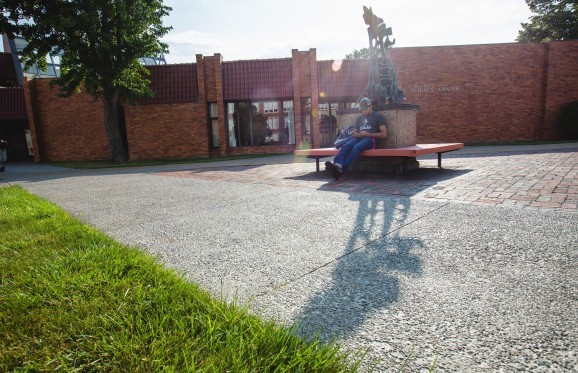Learning
Science division students present research and internship results at annual forum
More than a dozen Muskingum University science division students made presentations on their research and internship experiences at the university’s annual Research and Internship Forum.
The event requires participating students to create poster presentations of their work during the last year and to answer questions from both faculty and student attendees. The presentations are intended to help aspiring science students plan their future work, and to challenge participants to effectively report on their experiences and research findings.
The following students made presentations:
Shea Groves ’11 presented Akron Zoo: Zoo Camp Internship, in conjunction with the department of biology, about her efforts to assist in the zoo’s many educational programs.
Heather Henry ’12 presented Effects Of Nutlin-3 In Reducing Uv-Induced Oxidative DNA Damage In Human Melanocytes, in conjunction with the university’s molecular biology program, concerning the increased incidence of cutaneous melanoma in Caucasian people.
Rachel Hentz ’12 presented Water Quality Assessment of the Salt Creek Watershed In Eastern Muskingum County, Ohio, with the university’s environmental science program, and focused on water quality issues in The Salt Creek Watershed Project.
Sasha Eby ’11 and Kristen Fuller ’11 presented Brains R Us: A Brain Awareness Outreach Program at the Florida School for the Deaf and Blind (FSDB), in conjunction with the university’s neuroscience program, centered on a brain awareness outreach program conducted at the school in St Augustine, Florida.
Melanie Cox ’12 presented Audubon Nature Institute’s Freeport-McMoran Species Survival Center, in conjunction with the university’s department of biology, and focused on research techniques that involve in vitro fertilization and cloning to help preserve endangered species.
Douglas R. McClain ’11 presented Does Breeding Bird Density Drive Vocal Individuality?, in conjunction with university’s department of biology, which focused on sociability as an important driver in creating individuality.
Hallie Nesselroad ’11 presented The Presence of Toxoplasma Gondii at The Wilds, in conjunction with the university’s department of biology, and focused on the toxic effects of toxoplasma gondii on a variety of species.
Katy Cicigoi ’13 presented Summer Internship at Penitentiary Glen, in conjunction with the university’s conservation science program, and which concentrated on the Wildlife Rehabilitation Center of Penitentiary Glen in Willoughby, Ohio.
Joseph S. Castle ’12 presented Identification of Peptides That Bind to the Motor Pathway Protein S6k1, in conjunction with the university’s department of mathematics and computer science and the department of chemistry, and focused on the detection of cognitive-related proteins in the detection of memory formation and enhancement of short and long term memory.
Jenna Parrish ’11 presented Effects of Candesartan on Forced Swim Test Performance in Rats, in conjunction with the university’s neuroscience program, and focused on the relationship between major depression and cardiovascular disease.
Camelia Marina Petre ’11 presented Applications of Galloping Instabilities for Micro-Energy Harvesting: An Overview and Analysis, in conjunction with the university’s department of physics and engineering, which focused on an aerodynamic instability phenomena known as galloping as a way of harvesting wind based energy.
Seth Barrett ’11 presented Synthesis Of Dendron-Functionalized Cadmium-Based, Bisterpyridine Hexameric Metallomacromolecules, in conjunction with the university’s department of chemistry, and involved the synthesis of terpyridine-based materials for potential uses in dye and sensor applications.
Kyle Axe ’11 presented Active and Abandoned Sites of Castor Canadensis on a Reclaimed Strip Mine Site, in conjunction with the university’s department of biology, and concentrated on the ability of the American Beaver to alter habitats.
James Siford ’12 presented Estimating The Number of White-Tailed Deer (Odocoileus Virginianus) Among The Various Habitats at The Wilds, in conjunction with the university’s conservation science program and focused on establishing accurate deer populations in a variety of habitats at The Wilds. Siford also presented Trail Crew for the United States Forest Service in Saguache, Colorado, in conjunction with the university’s conservation science program, and focused on rail work over 70 miles of trail in the San Juan Mountains, and the Sangre De Christo mountains.
Derek Simonette ’12 presented Identification of Unknown Metallic Materials Determined by X-Ray Fluorescence at Metallurg Vanadium, in conjunction with the university’s department of physics and engineering, and concentrated on the proper disposal of unknown materials in a manufacturing environment.
Alissa Anderson ’11 presented Embryo Culture of Freshwater Mussels in Various Artificial Nutrient Media to Achieve Transformation, in conjunction with the university’s department of biology, and focused on freshwater mussels play as an important role in the health and maintenance of the freshwater systems they inhabit.
Jeffrey Storz ’11 presented Vegetation And Habitat Selection For Bobcats (Lynx Rufus) and Coyotes (Canis Latrans): Reclaimed Surface Mine Area at The Wilds, in conjunction with the university’s department of biology, and focused on the extent to which reclaimed surface mines are inhabited by larger carnivorous mammals such as bobcats (Lynx rufus) and coyotes (Canis latrans).
Jeremy Whitson ’13 presented Sustainability of Grassland Nesting Birds on a Reclaimed Surface Mine, in conjunction with the university’s department of biology, and concentrated on the importance of reclaimed mining land to grassland nesting birds.